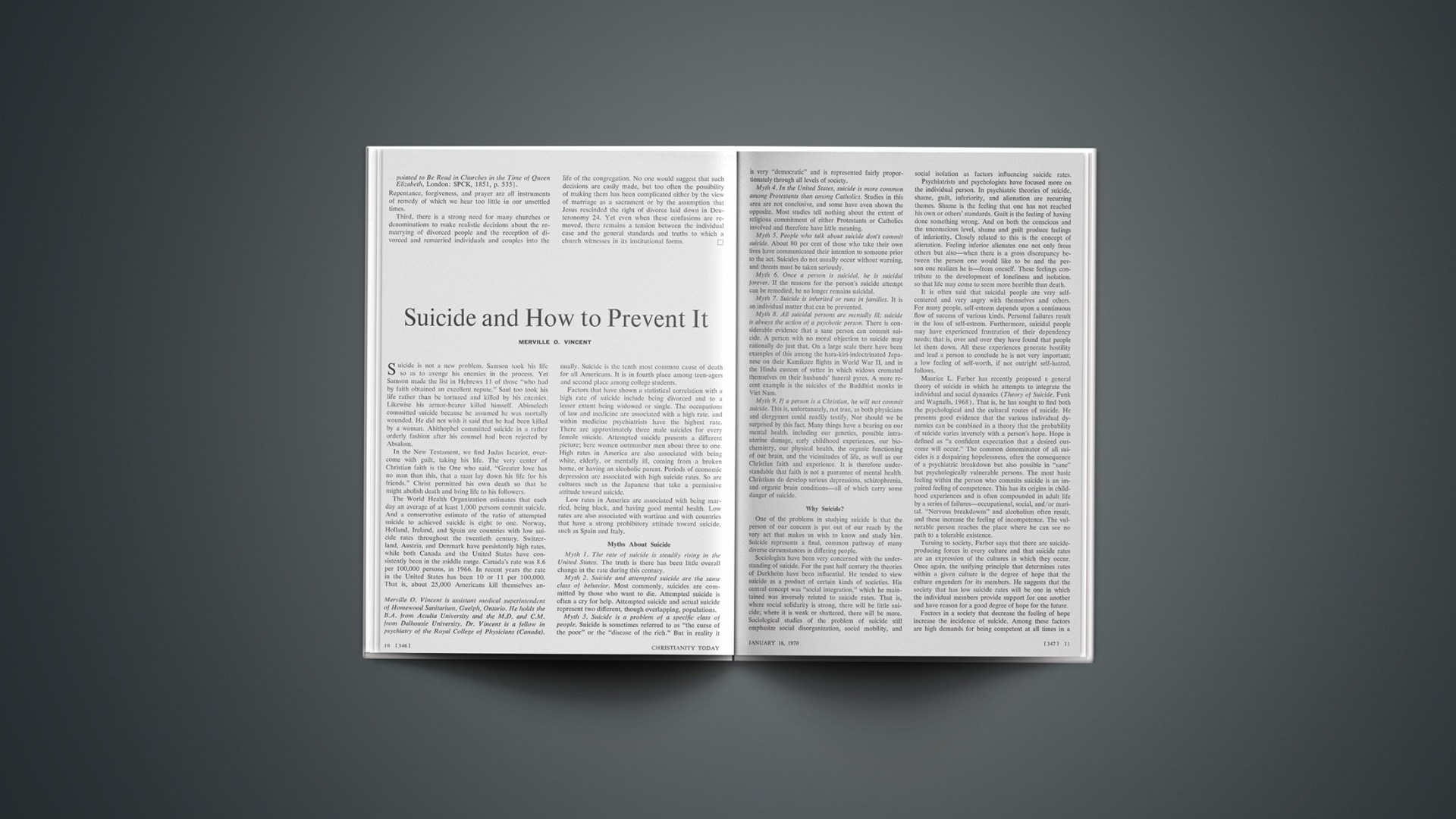Suicide is not a new problem. Samson took his life so as to avenge his enemies in the process. Yet Samson made the list in Hebrews 11 of those “who had by faith obtained an excellent repute.” Saul too took his life rather than be tortured and killed by his enemies. Likewise his armor-bearer killed himself. Abimelech committed suicide because he assumed he was mortally wounded. He did not wish it said that he had been killed by a woman. Ahithophel committed suicide in a rather orderly fashion after his counsel had been rejected by Absalom.
In the New Testament, we find Judas Iscariot, overcome with guilt, taking his life. The very center of Christian faith is the One who said, “Greater love has no man than this, that a man lay down his life for his friends.” Christ permitted his own death so that he might abolish death and bring life to his followers.
The World Health Organization estimates that each day an average of at least 1,000 persons commit suicide. And a conservative estimate of the ratio of attempted suicide to achieved suicide is eight to one. Norway, Holland, Ireland, and Spain are countries with low suicide rates throughout the twentieth century. Switzerland, Austria, and Denmark have persistently high rates, while both Canada and the United States have consistently been in the middle range. Canada’s rate was 8.6 per 100,000 persons, in 1966. In recent years the rate in the United States has been 10 or 11 per 100,000. That is, about 25,000 Americans kill themselves annually. Suicide is the tenth most common cause of death for all Americans. It is in fourth place among teen-agers and second place among college students.
Factors that have shown a statistical correlation with a high rate of suicide include being divorced and to a lesser extent being widowed or single. The occupations of law and medicine are associated with a high rate, and within medicine psychiatrists have the highest rate. There are approximately three male suicides for every female suicide. Attempted suicide presents a different picture; here women outnumber men about three to one. High rates in America are also associated with being white, elderly, or mentally ill, coming from a broken home, or having an alcoholic parent. Periods of economic depression are associated with high suicide rates. So are cultures such as the Japanese that take a permissive attitude toward suicide.
Low rates in America are associated with being married, being black, and having good mental health. Low rates are also associated with wartime and with countries that have a strong prohibitory attitude toward suicide, such as Spain and Italy.
Myths About Suicide
Myth 1. The rate of suicide is steadily rising in the United States. The truth is there has been little overall change in the rate during this century.
Myth 2. Suicide and attempted suicide are the same class of behavior. Most commonly, suicides are committed by those who want to die. Attempted suicide is often a cry for help. Attempted suicide and actual suicide represent two different, though overlapping, populations.
Myth 3. Suicide is a problem of a specific class of people. Suicide is sometimes referred to as “the curse of the poor” or the “disease of the rich.” But in reality it is very “democratic” and is represented fairly proportionately through all levels of society.
Myth 4. In the United States, suicide is more common among Protestants than among Catholics. Studies in this area are not conclusive, and some have even shown the opposite. Most studies tell nothing about the extent of religious commitment of either Protestants or Catholics involved and therefore have little meaning.
Myth 5. People who talk about suicide don’t commit suicide. About 80 per cent of those who take their own lives have communicated their intention to someone prior to the act. Suicides do not usually occur without warning, and threats must be taken seriously.
Myth 6. Once a person is suicidal, he is suicidal forever. If the reasons for the person’s suicide attempt can be remedied, he no longer remains suicidal.
Myth 7. Suicide is inherited or runs in families. It is an individual matter that can be prevented.
Myth 8. All suicidal persons are mentally ill; suicide is always the action of a psychotic person. There is considerable evidence that a sane person can commit suicide. A person with no moral objection to suicide may rationally do just that. On a large scale there have been examples of this among the hara-kiri-indoctrinated Japanese on their Kamikaze flights in World War II, and in the Hindu custom of suttee in which widows cremated themselves on their husbands’ funeral pyres. A more recent example is the suicides of the Buddhist monks in Viet Nam.
Myth 9. If a person is a Christian, he will not commit suicide. This is, unfortunately, not true, as both physicians and clergymen could readily testify. Nor should we be surprised by this fact. Many things have a bearing on our mental health, including our genetics, possible intrauterine damage, early childhood experiences, our biochemistry, our physical health, the organic functioning of our brain, and the vicissitudes of life, as well as our Christian faith and experience. It is therefore understandable that faith is not a guarantee of mental health. Christians do develop serious depressions, schizophrenia, and organic brain conditions—all of which carry some danger of suicide.
Why Suicide?
One of the problems in studying suicide is that the person of our concern is put out of our reach by the very act that makes us wish to know and study him. Suicide represents a final, common pathway of many diverse circumstances in differing people.
Sociologists have been very concerned with the understanding of suicide. For the past half century the theories of Durkheim have been influential. He tended to view suicide as a product of certain kinds of societies. His central concept was “social integration,” which he maintained was inversely related to suicide rates. That is, where social solidarity is strong, there will be little suicide; where it is weak or shattered, there will be more. Sociological studies of the problem of suicide still emphasize social disorganization, social mobility, and social isolation as factors influencing suicide rates.
Psychiatrists and psychologists have focused more on the individual person. In psychiatric theories of suicide, shame, guilt, inferiority, and alienation are recurring themes. Shame is the feeling that one has not reached his own or others’ standards. Guilt is the feeling of having done something wrong. And on both the conscious and the unconscious level, shame and guilt produce feelings of inferiority. Closely related to this is the concept of alienation. Feeling inferior alienates one not only from others but also—when there is a gross discrepancy between the person one would like to be and the person one realizes he is—from oneself. These feelings contribute to the development of loneliness and isolation, so that life may come to seem more horrible than death.
It is often said that suicidal people are very self-centered and very angry with themselves and others. For many people, self-esteem depends upon a continuous flow of success of various kinds. Personal failures result in the loss of self-esteem. Furthermore, suicidal people may have experienced frustration of their dependency needs; that is, over and over they have found that people let them down. All these experiences generate hostility and lead a person to conclude he is not very important; a low feeling of self-worth, if not outright self-hatred, follows.
Maurice L. Farber has recently proposed a general theory of suicide in which he attempts to integrate the individual and social dynamics (Theory of Suicide, Funk and Wagnalls, 1968). That is, he has sought to find both the psychological and the cultural routes of suicide. He presents good evidence that the various individual dynamics can be combined in a theory that the probability of suicide varies inversely with a person’s hope. Hope is defined as “a confident expectation that a desired outcome will occur.” The common denominator of all suicides is a despairing hopelessness, often the consequence of a psychiatric breakdown but also possible in “sane” but psychologically vulnerable persons. The most basic feeling within the person who commits suicide is an impaired feeling of competence. This has its origins in childhood experiences and is often compounded in adult life by a series of failures—occupational, social, and/or marital. “Nervous breakdowns” and alcoholism often result, and these increase the feeling of incompetence. The vulnerable person reaches the place where he can see no path to a tolerable existence.
Turning to society, Farber says that there are suicide-producing forces in every culture and that suicide rates are an expression of the cultures in which they occur. Once again, the unifying principle that determines rates within a given culture is the degree of hope that the culture engenders for its members. He suggests that the society that has low suicide rates will be one in which the individual members provide support for one another and have reason for a good degree of hope for the future.
Factors in a society that decrease the feeling of hope increase the incidence of suicide. Among these factors are high demands for being competent at all times in a very competitive, unforgiving milieu, or demands for a great deal of interpersonal giving. The person who lacks a feeling of competence may need to be dependent and may find himself unable to give.
Christian Faith And Suicide
If hope is the best preventative for suicide, does Christianity play a role? Our God is called by Paul “the God of hope” (Rom. 15:13). A relationship with Jesus Christ promises the individual a forgiveness that takes away shame and guilt, and an ultimate promise to wipe out all the differences between the ideal self and the real self. This makes living with one’s real self a lot easier and brings meaning and purpose into life. One is related not only to a heavenly Father in a mutual love relationship from which obedience follows readily but also, as a result, to all of mankind. Fellow men are seen in a different light. They are no longer just threats to one’s hopes and securities in the battle for survival; they are those for whom Christ came to earth and gave up his life in love. A relationship with Christ offers a new sense of personal worth. Feelings of incompetence and hopelessness are countered by the awareness of God’s love and concern.
These changes within a person instill a new hope. The threats in the external world are put in a new perspective, for when a person comes into a relationship with Christ, his whole value-system changes. No longer are his primary concerns those things that moths can get at and rust can ruin; no longer are the fragile status symbols necessary. The prime value to the Christian is his loving relationship with God through Christ. The ordinary threats to material existence such as financial loss, loss of reputation, suffering, tragedy—these have a totally new meaning. Even aging and death are positive experiences for those who increasingly value their relationship with Christ, and who increasingly are less concerned about their material possessions. For them, death is freedom from physical limitations of this world and a new closeness to their primary love-object. It is of interest to compare the hope of Paul as found in Romans 8:31–38 with the hope of Nietzsche, who said that the thought of suicide is sometimes “a great consolation; by means of it one gets successfully through many a bad night.”
A society that does not offer much hope is said to have a higher rate of suicide. There seems to be much that works against hope in our society today. As one looks at the problems of racial strife, war, civil disobedience, inequality of law, the extremes of the far right and the new left, poverty, exploding population, violence, and escape in drugs, one wonders why there are not more suicides.
Christian faith offers a view of life and history based on faith in the sovereign God of the universe; this results in an attitude neither paralyzed by the pessimism of the modern existentialist nor headed for the later discouragement of the modern utopian. Christians see a reasonable hope in this world and a perfect hope in the world to come. Within this framework, they are free—indeed, compelled—to work for the betterment of mankind and the relief of human suffering.
The Challenge Of Suicide
As Christians, we cannot condone suicide. We believe in the sanctity of every human life, a sanctity derived from the fact that man is created in the image of God. However, as Christians we must relate to others in a manner that shows that our opposition to suicide does not mean that we lack sympathy for those who have committed suicide or are contemplating it, or for those who are left behind after suicide.
Christians have been in the forefront of society in expressing their desire to prevent suicide. The first modern American suicide-prevention agency was the “Save a Life League” begun in New York City by a Baptist minister, Harry Warren, in 1906. In the same year in London, the Salvation Army launched its Anti-Suicide Bureau. Both of these organizations still function. In 1953 the Samaritans started a similar program in London initiated by an Anglican clergyman, Chad Varah; its primary purpose was the systematic befriending of ordinary people by ordinary people. By 1966 this organization had seventy-five branches in the British Isles. These services have been widely acclaimed in secular circles.
The problem of suicide is a challenge to us as individual Christians to exhibit an increased concern for those round about us. As the Church seeks to meet those needs in society that play a part in the chain of events leading to suicide, so must the individuals who are the Church meet these needs in other individuals. Dare we let the Christ-like life take over in us? Have we caught the significance of the fact that in serving and helping others, we are serving Christ? Do we really live as if Christ is present for us in suffering humanity? Are we as closely identified with the poor, the hungry, the sick, the imprisoned, the outcasts—that is, those without hope—as Christ was? Do we even want our indifference healed?
Louis I. Dublin concluded a sociological study of suicide by stating, “The remedy then is to make the social group more consistent and more coherent; to make its members realize their mutual interdependence; and to aim toward creating a society that fulfills the needs of each member in it” (Suicide: A Sociological and Statistical Study, Ronald Press, 1963). Similarly, Farber says, “Suicide will be reduced by the introduction into society of sources of hope, of institutions that foster the sense of competence, that supply something of succorance and even love.” This is the challenge!
Farber also describes the problem, however: “The established religions provide hope for some, but in the main they no longer engage the emotions sufficiently deeply to provide a nourishing, anti-suicidal hope.” I wonder if some of us share some blame for this last statement. While it is essential to be both orthodox and loving, it is essential to be known more for our love than for our orthodoxy!










